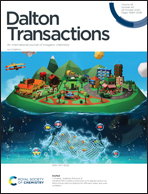A novel AB3-type trimeric zinc(ii)-phthalocyanine as an electrochromic and optical limiting material†
Abstract
Recent advances in the practical applications of metallophthalocyanines (MPcs) in different technological fields have stimulated us to design and synthesize a new asymmetric AB3-type trimeric zinc(II)-phthalocyanine (1). This bulky and high molecular weight compound was characterized by elemental analysis, 1H, 13C DEPT, and 1H-1H NOESY NMR, HR MALDI-TOF mass spectrometry, UV-vis, and FT-IR (ATR) techniques. In-depth electrochemical studies show that 1 displays quasi-reversible three one-electron reductions and two one- or two-electron oxidation processes, rather than any redox processes including the transfer of three-electrons in one-step. Besides this, in situ spectroelectrochemical measurements suggest the good application potential of 1 as an electrochromic material in display technologies. A study of the nonlinear optical properties (NLOs) of 1 reveals that the poly(methylmethacrylate) (PMMA) composite film displays a much larger nonlinear absorption coefficient and a lower saturable absorption threshold for optical limiting when compared to the same Pc molecules in solution. Ultrafast transient absorption measurements reveal the intersystem crossing mechanism. Density functional theory (DFT) was used for the geometry optimizations and time dependent-DFT (TD-DFT) for HOMO/LUMO energies and electronic transitions for 1.



 Please wait while we load your content...
Please wait while we load your content...